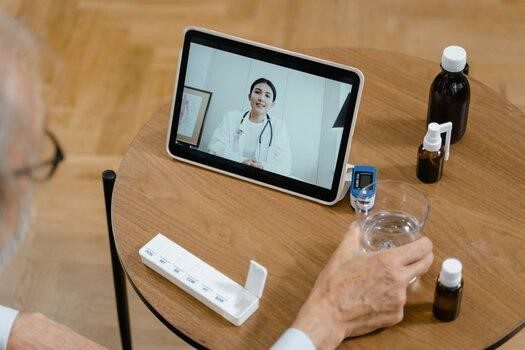
Image by Tima Miroshnichenko from Pexels
By: Megan Ng, Undergraduate Student of Food Science and Human Nutrition at the University of Illinois at Urbana Champaign
Telehealth
With so much of our lives are already online, so it is no surprise that the healthcare field is also following this trend. This online format of health care is known as telehealth. Telehealth allows for the access and delivery of health information through electronic sources.
Telehealth is becoming an important part of the current health care landscape. Furthermore, the pairing of technology and health services is getting more and more common nowadays. Telehealth may seem confusing, but it is simply an online doctor’s visit (with a lot more cool tools!).
Types of Telehealth
There are four main types of telehealth. Getting to know each one can help you prepare and feel more comfortable at your next appointment!
Live Video Conferencing (Synchronous)
These web-based visits are live, real-time appointments between patients and health care providers. The meetings take place on a video conferencing platform. This type of telehealth allows for consultation across geographical distances. The most significant advantage of live video conferencing is the “live” element. Live video conferencing allows for follow-up questions and discussion.
Asynchronous Video (Store-and-Forward)
Asynchronous video is not live, it is the electronic delivery of health records and documents. Feedback on tests and records are later provided by a health care professional. This type of telehealth is common in rural areas where health care may be more challenging to receive.
Asynchronous video, also called “store-and-forward” because patient data is stored on a secure platform. As a result, the data can be forwarded or accessed by other health professionals during care.
Remote Patient Monitoring (RPM)
This type of telehealth allows healthcare providers to collect and track patient health data remotely. Technology is used within the comfort of the patient’s home to measure specific health indicators. Remote patient monitoring allows health professionals to check in on patients more frequently. Remote patient monitoring is recommended for patients with chronic diseases or those in senior living spaces.
Mobile Health (mHealth)
Mobile health uses software and applications unlike the other types of telehealth. As a result, these tools can provide a variety of health-based services: (Maheu, 2020)
- Setting reminders to take medications
- Tracking daily movement
- Monitoring sleep cycle
Applications may be recommended to patients to supplement and improve lifestyle habits. Some applications may have an option for text messaging. Text messaging is a convenient way to get answers to specific health questions without scheduling an appointment.
Summary
Telehealth services and usage have increased tremendously in recent years. Telehealth has great potential to make health care much more accessible and efficient and has proved to be a very promising tool for improving the quality of life for many. Getting familiar with the different forms of telehealth will prepare you for the future of health care.
References:
- Maheu, M. (2020). Four Types of Telehealth: Advantages and Uses. Telehealth.org. Retrieved 24 September 2021, from https://telehealth.org/four-types-of-telehealth/.
- Mayo Clinic. (2020). Telehealth: Technology meets health care. Mayo Clinic. Retrieved 24 September 2021, from https://www.mayoclinic.org/healthy-lifestyle/consumer-health/in-depth/telehealth/art-20044878
- What is Telehealth?. Center for Connected Health Policy. Retrieved 24 September 2021, from https://www.cchpca.org/what-is-telehealth/.












